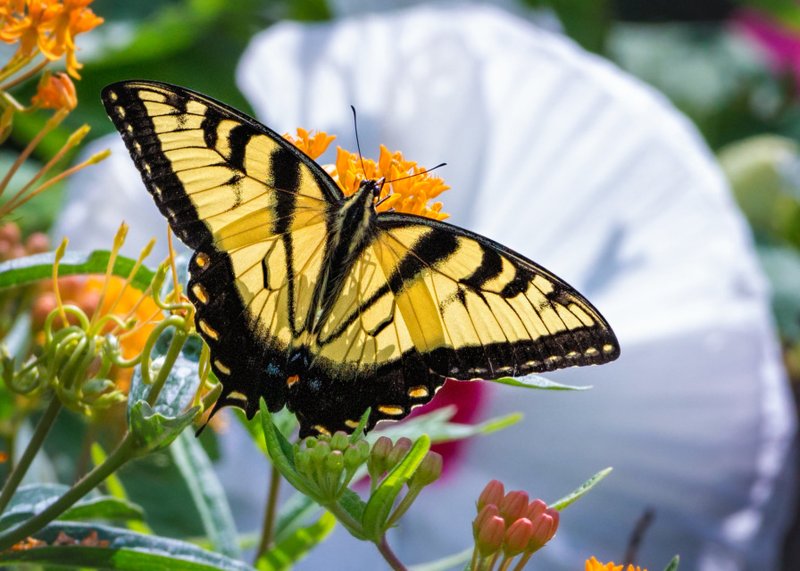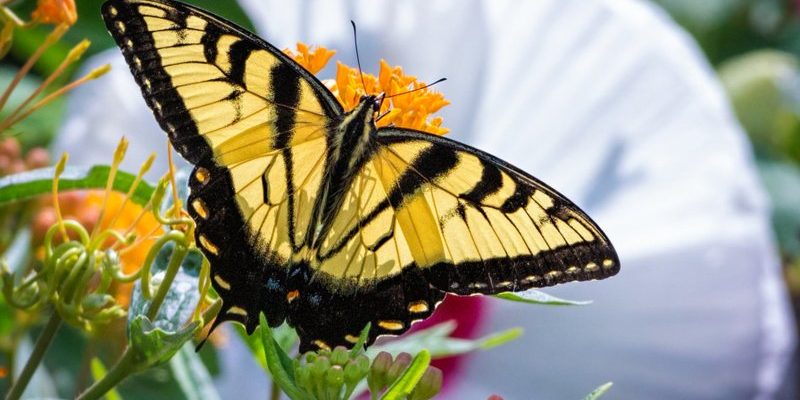
There’s something enchanting about watching a swallowtail butterfly in action. They’re not just there for a quick sip of nectar; they play important roles in the ecosystem. You might find yourself wondering about their lifecycle, the different species, and their fascinating behaviors. Sit back, grab your favorite beverage, and let’s dive into the world of swallowtail butterflies—the more you know, the more you’ll appreciate these tiny wonders fluttering around us!
1. A Rainbow of Species
When it comes to swallowtail butterflies, the variety is incredible. There are over 500 different species worldwide! Each species has its own unique color patterns and sizes. For example, the Eastern Tiger Swallowtail, a familiar sight in North America, sports bright yellow and black stripes, resembling a tiger’s coat. On the other hand, the magnificent Swallowtail from the tropics can dazzle you with iridescent blues and greens.
What’s fascinating is how these species adapt to their environments. Some thrive in wetland areas, while others prefer forested regions or fields. This diversity allows them to occupy various niches in their ecosystems, making them crucial players in maintaining ecological balance.
2. Life Cycle Marvels
The life cycle of a swallowtail butterfly is nothing short of magical. It goes through four distinct stages: egg, larva (caterpillar), pupa (chrysalis), and adult butterfly. Each stage has its own unique characteristics. For instance, the caterpillar stage is particularly fascinating. Swallowtail caterpillars often mimic the appearance of bird droppings or twigs, helping them avoid hungry predators.
Once they enter the pupa stage, a transformation occurs. Inside the chrysalis, the caterpillar is literally reimagining itself. This incredible process can take days to weeks, depending on the species and environmental conditions. After emerging, the adult butterfly is ready to take on the world—its first task? Drying its wings before that first flight!
3. Wing Patterns and Mimicry
Swallowtail butterflies are known for their striking wing patterns, but did you know these designs serve a purpose? Those eye-catching colors and shapes aren’t just for show; they act as defensive mechanisms. The bright colors can signal danger to potential predators, while the patterns can mimic the eyes of larger animals, which can scare off birds.
Interestingly, some swallowtail species exhibit mimicry. For instance, they might mimic the appearance of less palatable butterflies to avoid being eaten. This clever trick shows just how smart and adaptable these butterflies can be, ensuring their survival in the wild.
4. The Role of Swallowtails in Pollination
Swallowtail butterflies play a vital role in pollination, much like bees. As they flutter from flower to flower, they collect nectar, inadvertently transferring pollen in the process. This interaction is crucial for the reproduction of many plants. Without pollinators like swallowtails, many flowers wouldn’t be able to produce seeds and fruit, which could disrupt local ecosystems.
You might wonder how they maintain this important role. Swallowtails have long proboscises that allow them to reach deep into flowers for nectar. This adaptation makes them particularly effective pollinators, as they can access blooms that other insects might miss.
5. Not Just Pretty Faces
While swallowtail butterflies are undeniably beautiful, they also have unique behaviors that set them apart. For instance, many species exhibit territorial behavior, where males will patrol specific areas to attract females. This can lead to some competitive displays, as males challenge each other for the prime spots.
Additionally, swallowtails are known for their migratory patterns. Some species, like the Eastern Tiger Swallowtail, may migrate to escape harsh winter conditions. This remarkable ability to travel long distances adds another layer of intrigue to their life history.
6. Chemical Warfare: Defense Mechanisms
Swallowtail caterpillars don’t just rely on camouflage; they also have some interesting defense mechanisms. Many species feed on host plants that contain toxic compounds. These chemicals can make caterpillars unpalatable to predators. Some swallowtails even store these toxins in their bodies, making them unappetizing for birds and other hungry creatures.
As adults, they may also exude foul-smelling substances when threatened, further deterring predators. Their ability to combine bright colors with chemical defenses creates a powerful survival strategy in the natural world.
7. Cultural Significance
Throughout history, swallowtail butterflies have held cultural significance in various societies. In many cultures, they symbolize transformation, hope, and beauty. This is largely due to their breathtaking metamorphosis from caterpillar to butterfly. Art, literature, and folklore often celebrate their elegance and fragility.
For example, in certain Native American cultures, swallowtail butterflies are regarded as messengers. They are believed to carry wishes to the spirits, reflecting their connection to nature and the cycle of life. By understanding their place in different cultures, we can appreciate these butterflies on a deeper level.
8. Conservation Challenges
Despite their beauty, swallowtail butterflies face several challenges due to habitat loss, climate change, and pesticide use. Many species are losing their natural habitats as urban development expands, putting them at risk. This rapid change impacts their life cycles and food sources.
Conservation efforts are crucial to ensure the survival of these stunning butterflies. Planting native flowers, reducing pesticide use, and preserving their habitats can help safeguard their populations. Every little action counts. It’s a collective effort to give these butterflies the chance to thrive in our ecosystems.
9. Keep Your Eyes Open
If you’ve ever seen a swallowtail butterfly up close, you know how mesmerizing they can be. Bringing them into your garden can be as simple as planting the right flowers. Swallowtails are attracted to nectar-rich blooms like lantana, coneflowers, and milkweed. You can create a beautiful butterfly garden that supports their populations while enjoying their grace.
So, when you catch a glimpse of a swallowtail fluttering by, take a moment to appreciate the hard work that went into its creation. Notice the colors, the patterns, and the delicate dance it performs in your garden. They’re more than just beautiful; they’re a testament to nature’s artistry.
10. Future of Swallowtails
As we continue to learn about swallowtail butterflies, the future looks promising. Citizen science projects encourage people to observe and report butterfly sightings, contributing to research on their populations. These efforts help scientists understand how environmental changes impact swallowtails and other butterfly species.
With greater awareness, we can all play a part in preserving these incredible creatures. Remember, each swallowtail you see is not just a butterfly; it’s a piece of the natural world’s puzzle. By caring for the environment and advocating for conservation, we can ensure that future generations will enjoy the sight of these beautiful butterflies.
In conclusion, swallowtail butterflies are so much more than just beautiful insects. They represent a complex interplay of life, migration, and survival. Their vibrant colors and fascinating behaviors remind us of the importance of nature’s balance. The next time you see a swallowtail fluttering by, take a moment to appreciate all the hard work that goes into making each butterfly a tiny marvel.

